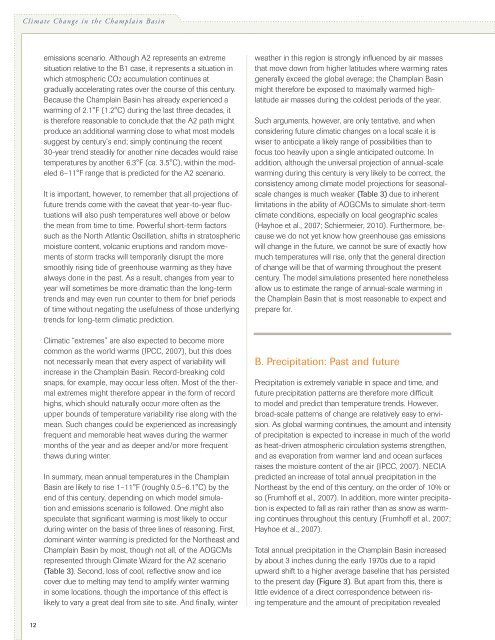Climate Change in the Champlain Basin - The Nature Conservancy
Climate Change in the Champlain Basin - The Nature Conservancy
Climate Change in the Champlain Basin - The Nature Conservancy
Create successful ePaper yourself
Turn your PDF publications into a flip-book with our unique Google optimized e-Paper software.
<strong>Climate</strong> <strong>Change</strong> <strong>in</strong> <strong>the</strong> Champla<strong>in</strong> Bas<strong>in</strong>emissions scenario. Although A2 represents an extremesituation relative to <strong>the</strong> B1 case, it represents a situation <strong>in</strong>which atmospheric CO2 accumulation cont<strong>in</strong>ues atgradually accelerat<strong>in</strong>g rates over <strong>the</strong> course of this century.Because <strong>the</strong> Champla<strong>in</strong> Bas<strong>in</strong> has already experienced awarm<strong>in</strong>g of 2.1°F (1.2°C) dur<strong>in</strong>g <strong>the</strong> last three decades, itis <strong>the</strong>refore reasonable to conclude that <strong>the</strong> A2 path mightproduce an additional warm<strong>in</strong>g close to what most modelssuggest by century’s end; simply cont<strong>in</strong>u<strong>in</strong>g <strong>the</strong> recent30-year trend steadily for ano<strong>the</strong>r n<strong>in</strong>e decades would raisetemperatures by ano<strong>the</strong>r 6.3°F (ca. 3.5°C), with<strong>in</strong> <strong>the</strong> modeled6–11°F range that is predicted for <strong>the</strong> A2 scenario.It is important, however, to remember that all projections offuture trends come with <strong>the</strong> caveat that year-to-year fluctuationswill also push temperatures well above or below<strong>the</strong> mean from time to time. Powerful short-term factorssuch as <strong>the</strong> North Atlantic Oscillation, shifts <strong>in</strong> stratosphericmoisture content, volcanic eruptions and random movementsof storm tracks will temporarily disrupt <strong>the</strong> moresmoothly ris<strong>in</strong>g tide of greenhouse warm<strong>in</strong>g as <strong>the</strong>y havealways done <strong>in</strong> <strong>the</strong> past. As a result, changes from year toyear will sometimes be more dramatic than <strong>the</strong> long-termtrends and may even run counter to <strong>the</strong>m for brief periodsof time without negat<strong>in</strong>g <strong>the</strong> usefulness of those underly<strong>in</strong>gtrends for long-term climatic prediction.Climatic “extremes” are also expected to become morecommon as <strong>the</strong> world warms (IPCC, 2007), but this doesnot necessarily mean that every aspect of variability will<strong>in</strong>crease <strong>in</strong> <strong>the</strong> Champla<strong>in</strong> Bas<strong>in</strong>. Record-break<strong>in</strong>g coldsnaps, for example, may occur less often. Most of <strong>the</strong> <strong>the</strong>rmalextremes might <strong>the</strong>refore appear <strong>in</strong> <strong>the</strong> form of recordhighs, which should naturally occur more often as <strong>the</strong>upper bounds of temperature variability rise along with <strong>the</strong>mean. Such changes could be experienced as <strong>in</strong>creas<strong>in</strong>glyfrequent and memorable heat waves dur<strong>in</strong>g <strong>the</strong> warmermonths of <strong>the</strong> year and as deeper and/or more frequentthaws dur<strong>in</strong>g w<strong>in</strong>ter.In summary, mean annual temperatures <strong>in</strong> <strong>the</strong> Champla<strong>in</strong>Bas<strong>in</strong> are likely to rise 1–11°F (roughly 0.5–6.1°C) by <strong>the</strong>end of this century, depend<strong>in</strong>g on which model simulationand emissions scenario is followed. One might alsospeculate that significant warm<strong>in</strong>g is most likely to occurdur<strong>in</strong>g w<strong>in</strong>ter on <strong>the</strong> basis of three l<strong>in</strong>es of reason<strong>in</strong>g. First,dom<strong>in</strong>ant w<strong>in</strong>ter warm<strong>in</strong>g is predicted for <strong>the</strong> Nor<strong>the</strong>ast andChampla<strong>in</strong> Bas<strong>in</strong> by most, though not all, of <strong>the</strong> AOGCMsrepresented through <strong>Climate</strong> Wizard for <strong>the</strong> A2 scenario(Table 3). Second, loss of cool, reflective snow and icecover due to melt<strong>in</strong>g may tend to amplify w<strong>in</strong>ter warm<strong>in</strong>g<strong>in</strong> some locations, though <strong>the</strong> importance of this effect islikely to vary a great deal from site to site. And f<strong>in</strong>ally, w<strong>in</strong>terwea<strong>the</strong>r <strong>in</strong> this region is strongly <strong>in</strong>fluenced by air massesthat move down from higher latitudes where warm<strong>in</strong>g ratesgenerally exceed <strong>the</strong> global average; <strong>the</strong> Champla<strong>in</strong> Bas<strong>in</strong>might <strong>the</strong>refore be exposed to maximally warmed highlatitudeair masses dur<strong>in</strong>g <strong>the</strong> coldest periods of <strong>the</strong> year.Such arguments, however, are only tentative, and whenconsider<strong>in</strong>g future climatic changes on a local scale it iswiser to anticipate a likely range of possibilities than tofocus too heavily upon a s<strong>in</strong>gle anticipated outcome. Inaddition, although <strong>the</strong> universal projection of annual-scalewarm<strong>in</strong>g dur<strong>in</strong>g this century is very likely to be correct, <strong>the</strong>consistency among climate model projections for seasonalscalechanges is much weaker (Table 3) due to <strong>in</strong>herentlimitations <strong>in</strong> <strong>the</strong> ability of AOGCMs to simulate short-termclimate conditions, especially on local geographic scales(Hayhoe et al., 2007; Schiermeier, 2010). Fur<strong>the</strong>rmore, becausewe do not yet know how greenhouse gas emissionswill change <strong>in</strong> <strong>the</strong> future, we cannot be sure of exactly howmuch temperatures will rise, only that <strong>the</strong> general directionof change will be that of warm<strong>in</strong>g throughout <strong>the</strong> presentcentury. <strong>The</strong> model simulations presented here none<strong>the</strong>lessallow us to estimate <strong>the</strong> range of annual-scale warm<strong>in</strong>g <strong>in</strong><strong>the</strong> Champla<strong>in</strong> Bas<strong>in</strong> that is most reasonable to expect andprepare for.B. Precipitation: Past and futurePrecipitation is extremely variable <strong>in</strong> space and time, andfuture precipitation patterns are <strong>the</strong>refore more difficultto model and predict than temperature trends. However,broad-scale patterns of change are relatively easy to envision.As global warm<strong>in</strong>g cont<strong>in</strong>ues, <strong>the</strong> amount and <strong>in</strong>tensityof precipitation is expected to <strong>in</strong>crease <strong>in</strong> much of <strong>the</strong> worldas heat-driven atmospheric circulation systems streng<strong>the</strong>n,and as evaporation from warmer land and ocean surfacesraises <strong>the</strong> moisture content of <strong>the</strong> air (IPCC, 2007). NECIApredicted an <strong>in</strong>crease of total annual precipitation <strong>in</strong> <strong>the</strong>Nor<strong>the</strong>ast by <strong>the</strong> end of this century, on <strong>the</strong> order of 10% orso (Frumhoff et al., 2007). In addition, more w<strong>in</strong>ter precipitationis expected to fall as ra<strong>in</strong> ra<strong>the</strong>r than as snow as warm<strong>in</strong>gcont<strong>in</strong>ues throughout this century (Frumhoff et al., 2007;Hayhoe et al., 2007).Total annual precipitation <strong>in</strong> <strong>the</strong> Champla<strong>in</strong> Bas<strong>in</strong> <strong>in</strong>creasedby about 3 <strong>in</strong>ches dur<strong>in</strong>g <strong>the</strong> early 1970s due to a rapidupward shift to a higher average basel<strong>in</strong>e that has persistedto <strong>the</strong> present day (Figure 3). But apart from this, <strong>the</strong>re islittle evidence of a direct correspondence between ris<strong>in</strong>gtemperature and <strong>the</strong> amount of precipitation revealed12
















